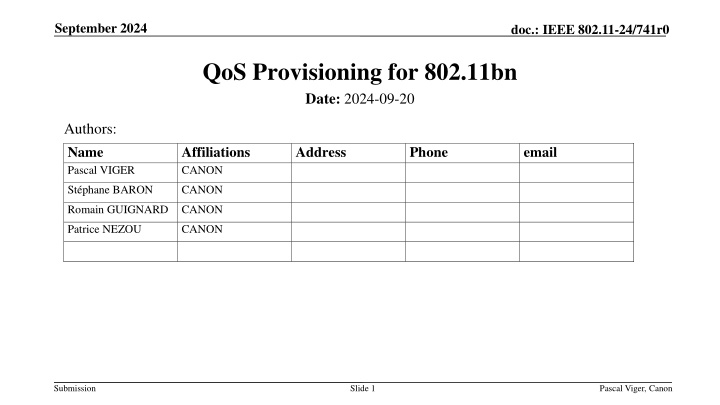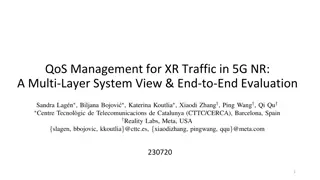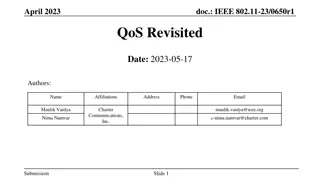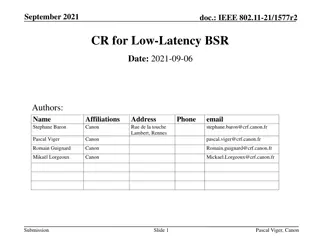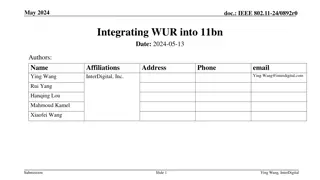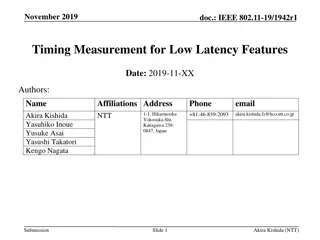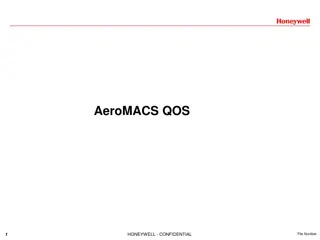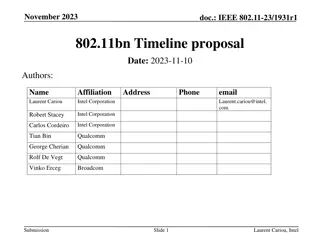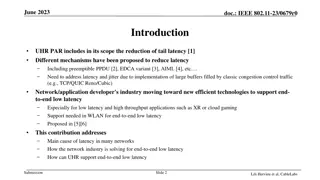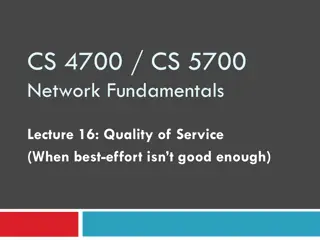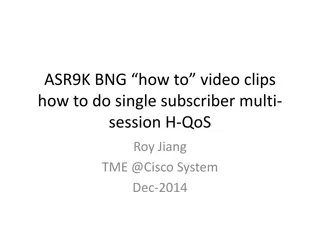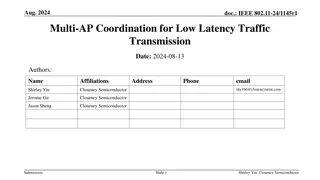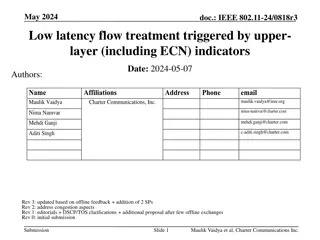QoS Provisioning for Low Latency Traffic in IEEE 802.11bn
Highlighting deficiencies in managing UL latency-sensitive traffic in IEEE 802.11 networks, this document discusses enhancements for prioritizing UL flows and improving QoS support for real-time applications. Topics include traffic classification, QoS requirements, and proposals like Restricted TWT to enhance low latency traffic transmission.
Download Presentation

Please find below an Image/Link to download the presentation.
The content on the website is provided AS IS for your information and personal use only. It may not be sold, licensed, or shared on other websites without obtaining consent from the author.If you encounter any issues during the download, it is possible that the publisher has removed the file from their server.
You are allowed to download the files provided on this website for personal or commercial use, subject to the condition that they are used lawfully. All files are the property of their respective owners.
The content on the website is provided AS IS for your information and personal use only. It may not be sold, licensed, or shared on other websites without obtaining consent from the author.
E N D
Presentation Transcript
September 2024 doc.: IEEE 802.11-24/741r0 QoS Provisioning for 802.11bn Date: 2024-09-20 Authors: Name Pascal VIGER Affiliations CANON Address Phone email St phane BARON CANON Romain GUIGNARD CANON Patrice NEZOU CANON Submission Slide 1 Pascal Viger, Canon
September 2024 doc.: IEEE 802.11-24/741r0 Abstract In this contribution, we highlight some deficiencies to manage UL latency- sensitive traffic . Submission Slide 2 Pascal Viger, Canon
September 2024 doc.: IEEE 802.11-24/741r0 Introduction UHR PAR [1] is aiming to provide improved low latency support. Many applications such as video collaboration, XR, immersive education/training, real-time gaming, robotics etc. require support for low end-to-end latency and jitter. [2] A LL stream with stringent requirements would benefit from prioritized, guaranteed channel access opportunity even before regular EDCA start. There have been several contributions discussing the explicit knowledge of the traffic classification and QoS requirement of STA : SCS agreement is established between the associated AP and STA. SCS enables the AP to classify and handle specific MSDUs based on parameters provided by the STA, significantly improving QoS for real-time applications. However, there are still deficiencies to schedule/trigger UL latency-sensitive traffic. Submission Slide 3 Pascal Viger, Canon
September 2024 doc.: IEEE 802.11-24/741r0 Context / Problem statement Several 11bn contributions discuss how to prioritize UL traffic flows. As example : Doc 11-24/397: Support for End-to-End QoS There can be multiple UL flows active from a given STA for a given TID e.g. video collaboration while a live sports stream running in the background, both flows mapped to same TID. TCLAS info is needed to classify flows and apply flow level policy (based on IP tuple); UL TCLAS needs to be provided for SCS Request with UL QoS Characteristics, then UL TCLAS allows an AP to apply flow level policy for SCS requests and allocate UL resources, e.g. trigger frequently with enough RU allocation. Doc 11-24/463: QoS enhancements for UHR-follow-up multiple traffic streams are mapped to same AC between two STAs such as multiple voice/ video sessions, time-sensitive flows, file transfer instances We can sort or map each SCS flow to a unique TID if we don t have too many such flows Clearly, this is a problem if the number of such streams exceed the number of TIDs that can today be mapped to an AC. Submission Slide 4 Pascal Viger, Canon
September 2024 doc.: IEEE 802.11-24/741r0 Context / Problem statement (cont.) Restricted TWT (TGbe) Restricted TWT (R-TWT) has been proposed in TGbe to improve the QoS of low latency (LL) traffic R-TWT is built on top of broadcast TWT, which defines certain time periods that are prioritized for LL traffic transmission, including: AP can trigger member STAs to transmit UL frames of R-TWT UL TIDs Coordinated R-TWT has been discussed extensively in UHR and TGbn to improve the latency performance in the Multi-BSS scenario. Submission Slide 5 Pascal Viger, Canon
September 2024 doc.: IEEE 802.11-24/741r0 Discussion 3 main elements have to be considered for latency-sensitive stream: Buffer status report (BSR) is used to indicate to the AP the amount of data the STA has available in its queues for transmission. BSRs takes the form of QoS-Control with Queue Size, or BSR-Control BSR can be solicited by a TF Trigger Frame is used by AP to control medium access and trigger a specific stream Restricted-TWT (rTWT) : UL/DL TID bitmap Current issues (not solved in 11be): BSR: BSRs work at AC level (Queue Size subfield, Queue Size All subfield) From 11-24/0091: Considering only the TIDs may not be adequate to schedule for event-based low-latency traffic. Trigger frame : Today, only Preferred AC may be identified rTWT: Problem is that a TID can also contain non latency sensitive (non-LL) data, thus it is unfair to transport those non-LL data as well as highest-priority LL data. Submission Slide 6 Pascal Viger, Canon
September 2024 doc.: IEEE 802.11-24/741r0 Proposal It is therefore required to consider both TID and SCSID to qualify the stream in both BSRs and TFs for efficient UL MU operation : - SCSID-based low latency traffic differentiation mechanism, to be used by high-end STAs able to finely separate low latency data against normal data, - TID-based low latency traffic differentiation, for other STAs. Submission Slide 7 Pascal Viger, Canon
September 2024 doc.: IEEE 802.11-24/741r0 Example format to support TID and SCSID Trigger Frame is updated to trigger an SCS stream (through TID/SCSID): Applicable only to UHR STAs, Trigger Dependent User Info Format compatible with HE/EHT format B5 set to 1 indicates new UHR Trigger Dependent User Info field variant B2 (Trigger Dependent Type subfield) identifies the encoding of the UHR Trigger Dependent User Info field variant: Value 0: SCSID/TID subfields (part 1 and part 2) represent a TID value Value 1: SCSID/TID subfields (part 1 and part 2) represent an SCSID value B2 B0 B1 B6 B7 B5 B3 B4 MPDU MU Spacing factor 2 Presence of UHR format 1 Trigger Dependent Type 1 SCSID/TID part 1 SCSID/TID part 2 2 Bits: 2 Submission Slide 8 Pascal Viger, Canon
September 2024 doc.: IEEE 802.11-24/741r0 Summary The contribution presented some insights on QoS management to enhance the UL LL traffic triggering operation of 11bn. Submission Slide 9 Pascal Viger, Canon
September 2024 doc.: IEEE 802.11-24/741r0 References 1. 11-23/0480r3, UHR proposed PAR 2. 11-24/0470r0, Re-thinking latency: the missing pieces 3. 11-24/397, Support for End-to-End QoS 4. 11-24/463, QoS enhancements for UHR-follow-up 5. 11-24/0091, Enhanced Scheduling Method for Low Latency Traffic Follow up Submission Slide 10 Pascal Viger, Canon
September 2024 doc.: IEEE 802.11-24/741r0 Straw poll Do you agree to improve UL scheduling by explicit SCSID for Low Latency traffic ? example applications may be TF, BSR, R-TWT Submission Slide 11 Pascal Viger, Canon
